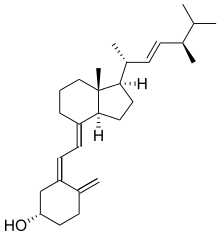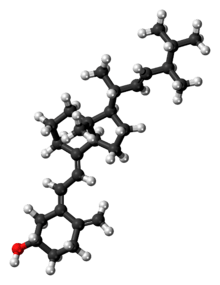Ergocalciferol
 | |
 | |
| Clinical data | |
|---|---|
| Trade names | Drisdol, Calcidol, others |
| Synonyms | viosterol |
| AHFS/Drugs.com | Monograph |
| Pregnancy category |
|
| ATC code | |
| Legal status | |
| Legal status |
|
| Identifiers | |
| |
| CAS Number | |
| PubChem CID | |
| DrugBank | |
| ChemSpider | |
| UNII | |
| KEGG | |
| ChEBI | |
| ChEMBL | |
| ECHA InfoCard |
100.000.014 |
| Chemical and physical data | |
| Formula | C28H44O |
| Molar mass | 396.65 g/mol |
| 3D model (JSmol) | |
| Melting point | 114 to 118 °C (237 to 244 °F) |
| |
| |
Ergocalciferol, also known as vitamin D2 and calciferol, is a type of vitamin D found in food and used as a dietary supplement.[1] As a supplement it is used to prevent and treat vitamin D deficiency.[2] This includes vitamin D deficiency due to poor absorption by the intestines or liver disease.[3] It may also be used for low blood calcium due to hypoparathyroidism.[3] It is used by mouth or injection into a muscle.[2][3]
Excessive doses can result in increased urine production, high blood pressure, kidney stones, kidney failure, weakness, and constipation.[4] If high doses are taken for a long period of time, tissue calcification may occur.[3] It is recommended that people on high doses have their blood calcium levels regularly checked.[2] Normal doses are safe in pregnancy.[5] It works by increasing the amount of calcium absorbed by the intestines and kidneys.[4] Food in which it is found include some mushrooms.[6]
Ergocalciferol was first described in 1936.[7] It is on the World Health Organization's List of Essential Medicines, the most effective and safe medicines needed in a health system.[8] Ergocalciferol is available as a generic medication and over the counter.[4] In the United Kingdom a typical dose costs the NHS less than 10 pounds a month.[2] Certain foods such as breakfast cereal and margarine have ergocalciferol added to them in some countries.[9][10]
Medical uses
Ergocalciferol may be used as a vitamin D supplement, whereas cholecalciferol (vitamin D3) is produced naturally by the skin when exposed to ultraviolet light.[11] Ergocalciferol (D2) and cholecalciferol (D3) are considered to be equivalent for vitamin D production, as both forms appear to have similar efficacy in ameliorating rickets[12] and reducing the incidence of falls in elderly patients.[13] Conflicting reports exist, however, concerning the relative effectiveness, with some studies suggesting that ergocalciferol has less efficacy based on limitations in absorption, binding, and inactivation.[14] A meta-analysis concluded that evidence usually favors cholecalciferol in raising levels in blood, although it stated more research is needed.[14]
Mechanism
Ergocalciferol is a secosteroid formed by a photochemical bond breaking of a steroid, specifically, by the action of ultraviolet light on ergosterol, a form of provitamin D2.
Like cholecalciferol, Ergocalciferol is inactive by itself. It requires two hydroxylations to become active: the first in the liver by CYP2R1 to form 25-hydroxyergocalciferol (ercalcidiol or 25-OH D2[15]), and the second in the kidney by CYP27B1, to form the active 1,25-dihydroxyergocalciferol (ercalcitriol or 1,25-(OH)2D2), which activates the vitamin D receptor.[16] Unlike cholecalciferol, 25-hydroxylation is not performed by CYP27A1 for ergocalciferol.[17]
Ergocalciferol and metabolites have lower affinity to the vitamin D-binding protein compared to the D3 counterparts. The binding affinity of ercalcitriol to the vitamin D receptor is similar to that of calcitriol.[17] Ergocalciferol itself and metabolites can be deactivated by 24-hydroxylation.[18]
Sources
Lichen
- Cladina arbuscula specimens grown under different natural conditions: The contents of vitamin D3 range from 0.67 to 2.04 μg/g (27 to 82 IU/g) dry matter in the thalli of C. arbuscula specimens grown under different natural conditions, while provitamin D3 could not be detected. The ranges for provitamin D2 and vitamin D2 were 89-146 and 0.22-0.55 μg/g (8.8 to 22 IU/g) dry matter, respectively, while the contents of provitamin D3 were below the detection limit (0.01 μg/g dry matter). Vitamin D levels correlate positively with UV irridation.[19]
Fungus, from USDA nutrient database (per 100g), D2 + D3:[20][21]
- Agaricus bisporus:
- raw portobello: 0.3 μg (10 IU); exposed to ultraviolet light: 11.2 µg (446 IU)
- raw crimini: 0.1 μg (3 IU); exposed to ultraviolet light: 31.9 µg (1276 IU)
- Mushrooms, shiitake:
- raw: Vitamin D (D2 + D3): 0.4 μg (18 IU)
- dried: Vitamin D (D2 + D3): 3.9 μg (154 IU)
Plantae
- Alfalfa (Medicago sativa subsp. sativa), shoot: 4.8 μg (192 IU) vitamin D2, 0.1 μg (4 IU) vitamin D3[22]
Biosynthesis
The vitamin D2 content in mushrooms and C. arbuscula increase with exposure to ultraviolet light.[23][24] Ergosterol (provitamin D2) found in these fungi is converted to previtamin D2 on UV exposure, which then turns into vitamin D2. If there is little exposure to UV light (or sunlight), little vitamin D will form.
When fresh mushrooms or dried powders are purposely exposed to artificial sunlight by use of an industrial ultraviolet lamp, vitamin D2 levels can be concentrated to much higher levels.[25][26][27] The irradiation procedure does not cause significant discoloration, or whitening, of mushrooms.[28] Claims have been made that a normal serving (approx. 2 oz or 60 grams) of fresh mushrooms treated with ultraviolet light have increased vitamin D content to levels up to 80 micrograms or 3200 IU if exposed to just 5 minutes of UV light after being harvested.[26]
Button mushrooms with enhanced vitamin D2 content produced this way functions similarly to a vitamin D2 supplement; both effectively improves vitamin D status.[25][29] Vitamin D2 from UV-irradiated yeast baked into bread or mushrooms is bioavailable and increases blood levels of 25(OH)D.[25]
Names
Viosterol, the name given to early preparations of irradiated ergosterol, is essentially synonymous with ergocalciferol.[30][31]
Ergocalciferol is manufactured and marketed under various names, including Deltalin (Eli Lilly and Company), Drisdol (Sanofi-Synthelabo) and Calcidol (Patrin Pharma).
References
- ↑ Coulston, Ann M.; Boushey, Carol; Ferruzzi, Mario (2013). Nutrition in the Prevention and Treatment of Disease. Academic Press. p. 818. ISBN 9780123918840. Archived from the original on 2016-12-30.
- 1 2 3 4 British national formulary : BNF 69 (69 ed.). British Medical Association. 2015. pp. 703–704. ISBN 9780857111562.
- 1 2 3 4 WHO Model Formulary 2008 (PDF). World Health Organization. 2009. p. 498. ISBN 9789241547659. Archived (PDF) from the original on 13 December 2016. Retrieved 8 December 2016.
- 1 2 3 "Ergocalciferol". The American Society of Health-System Pharmacists. Archived from the original on 30 December 2016. Retrieved 8 December 2016.
- ↑ Hamilton, Richart (2015). Tarascon Pocket Pharmacopoeia 2015 Deluxe Lab-Coat Edition. Jones & Bartlett Learning. p. 227. ISBN 9781284057560.
- ↑ "Office of Dietary Supplements - Vitamin D". ods.od.nih.gov. 11 February 2016. Archived from the original on 31 December 2016. Retrieved 30 December 2016.
- ↑ Fischer, Janos; Ganellin, C. Robin (2006). Analogue-based Drug Discovery. John Wiley & Sons. p. 451. ISBN 9783527607495. Archived from the original on 2016-12-30.
- ↑ "WHO Model List of Essential Medicines (19th List)" (PDF). World Health Organization. April 2015. Archived (PDF) from the original on 13 December 2016. Retrieved 8 December 2016.
- ↑ Feral, Priscilla; Hall, Lee; Animals, Friends of (2005). Dining with Friends: The Art of North American Vegan Cuisine. Friends of Animals/Nectar Bat Press. p. 160. ISBN 9780976915904. Archived from the original on 2016-12-31.
- ↑ Bennett, Beverly; Sammartano, Ray (2012). The Complete Idiot's Guide to Vegan Living, Second Edition. Penguin. p. Chapter 15. ISBN 9781615642793. Archived from the original on 2016-12-30.
- ↑ Holick, M. F.; Binkley, N. C.; Bischoff-Ferrari, H. A.; Gordon, C. M.; Hanley, D. A.; Heaney, R. P.; Murad, M. H.; Weaver, C. M. (2011). "Evaluation, Treatment, and Prevention of Vitamin D Deficiency: An Endocrine Society Clinical Practice Guideline". Journal of Clinical Endocrinology & Metabolism. 96 (7): 1911–1930. doi:10.1210/jc.2011-0385. PMID 21646368.
- ↑ Thacher, TD; Fischer, PR; Obadofin, MO; Levine, MA; Singh, RJ; Pettifor, JM (2010). "Comparison of Metabolism of Vitamins D2 and D3 in Children with Nutritional Rickets". Journal of Bone and Mineral Research. 25 (9): 1988–1995. doi:10.1002/jbmr.99. PMC 3153403. PMID 20499377.
- ↑ Fosnight, S. M.; Zafirau, W. J.; Hazelett, S. E. (2008). "Vitamin D Supplementation to Prevent Falls in the Elderly: Evidence and Practical Considerations". Pharmacotherapy. 28 (2): 225–234. doi:10.1592/phco.28.2.225. PMID 18225968.
- 1 2 Tripkovic, L; Lambert, H; Hart, K; Smith, CP; Bucca, G; Penson, S; Chope, G; Hyppönen, E; Berry, J; Vieth, R; Lanham-New, S (June 2012). "Comparison of vitamin D2 and vitamin D3 supplementation in raising serum 25-hydroxyvitamin D status: a systematic review and meta-analysis". The American Journal of Clinical Nutrition. 95 (6): 1357–64. doi:10.3945/ajcn.111.031070. PMC 3349454. PMID 22552031.
- ↑ Suda, T; DeLuca, HF; Schnoes, H; Blunt, JW (29 April 1969). "25-hydroxyergocalciferol: a biologically active metabolite of vitamin D2". Biochemical and Biophysical Research Communications. 35 (2): 182–5. PMID 5305760.
- ↑ "IUPAC-IUB Joint Commission on Biochemical Nomenclature (JCBN): Nomenclature of vitamin D. Recommendations 1981". European Journal of Biochemistry. 124 (2): 223–7. 17 May 1982. doi:10.1111/j.1432-1033.1982.tb06581.x. PMID 7094913.
- 1 2 Bikle, DD (20 March 2014). "Vitamin D metabolism, mechanism of action, and clinical applications". Chemistry & biology. 21 (3): 319–29. doi:10.1016/j.chembiol.2013.12.016. PMC 3968073. PMID 24529992.
- ↑ Houghton, LA; Vieth, R (October 2006). "The case against ergocalciferol (vitamin D2) as a vitamin supplement". The American Journal of Clinical Nutrition. 84 (4): 694–7. doi:10.1093/ajcn/84.4.694. PMID 17023693.
- ↑ Wang, T; Bengtsson, G; Kärnefelt, I; Björn, LO (2001). "Provitamins and vitamins D₂and D₃in Cladina spp. Over a latitudinal gradient: Possible correlation with UV levels". Journal of Photochemistry and Photobiology B: Biology. 62 (1–2): 118–22. doi:10.1016/S1011-1344(01)00160-9. PMID 11693362.
- ↑ "USDA nutrient database – use the keyword 'portabello' and then click submit". Archived from the original on 2015-02-22.
- ↑ Haytowitz DB (2009). "Vitamin D in mushrooms" (PDF). Nutrient Data Laboratory, US Department of Agriculture. Retrieved 16 April 2018.
- ↑ "Dr. Duke's Phytochemical and Ethnobotanical Databases". Archived from the original on 2015-10-16.
- ↑ Wang T, Bengtsson G, Kärnefelt I, Björn LO (September 2001). "Provitamins and vitamins D₂and D₃in Cladina spp. over a latitudinal gradient: possible correlation with UV levels". Journal of Photochemistry and Photobiology. B, Biology. 62 (1–2): 118–22. doi:10.1016/S1011-1344(01)00160-9. PMID 11693362.
- ↑ Haytowitz DB (2009). "Vitamin D in mushrooms" (PDF). Nutrient Data Laboratory, US Department of Agriculture. Retrieved 16 April 2018.
- 1 2 3 Keegan RJ, Lu Z, Bogusz JM, Williams JE, Holick MF (January 2013). "Photobiology of vitamin D in mushrooms and its bioavailability in humans". Dermato-Endocrinology. 5 (1): 165–76. doi:10.4161/derm.23321. PMC 3897585. PMID 24494050.
- 1 2 "Bringing Mushrooms Out of the Dark". MSNBC. April 18, 2006. Retrieved August 6, 2007.
- ↑ Simon RR, Borzelleca JF, DeLuca HF, Weaver CM (June 2013). "Safety assessment of the post-harvest treatment of button mushrooms (Agaricus bisporus) using ultraviolet light". Food and Chemical Toxicology. 56: 278–89. doi:10.1016/j.fct.2013.02.009. PMID 23485617.
- ↑ Koyyalamudi SR, Jeong SC, Song CH, Cho KY, Pang G (April 2009). "Vitamin D2 formation and bioavailability from Agaricus bisporus button mushrooms treated with ultraviolet irradiation". Journal of Agricultural and Food Chemistry. 57 (8): 3351–5. doi:10.1021/jf803908q. PMID 19281276.
- ↑ Urbain P, Singler F, Ihorst G, Biesalski HK, Bertz H (August 2011). "Bioavailability of vitamin D₂ from UV-B-irradiated button mushrooms in healthy adults deficient in serum 25-hydroxyvitamin D: a randomized controlled trial". European Journal of Clinical Nutrition. 65 (8): 965–71. doi:10.1038/ejcn.2011.53. PMID 21540874.
- ↑ Science Service (1930) Viosterol official name for irradiated ergosterol, J. Chem. Educ. 7(1) 166, DOI: 10.1021/ed007p166, see [pubs.acs.org/doi/abs/10.1021/ed007p166, accessed 10 July 2014.
- ↑ See "Viosterol" and "Calciferol" at Merriam-Webster Medical Dictionary, e.g., "Archived copy". Archived from the original on 2014-07-14. Retrieved 2014-07-10. and "Archived copy". Archived from the original on 2014-07-14. Retrieved 2014-07-10. , accessed 10 July 2014.